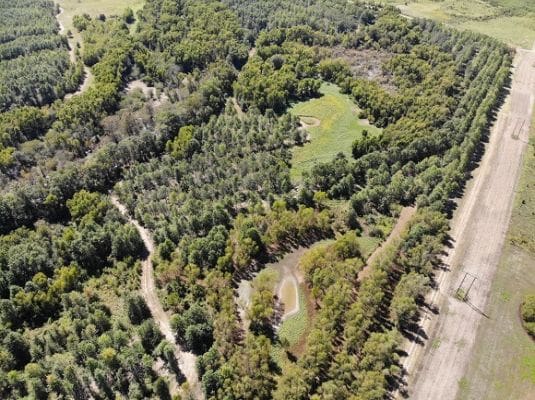Benefiting Imperiled Wetlands through Multi-Partner Collaboration

NWTF and USDA Natural Resources Conservation Service cooperative forester Sid Munford highlights the importance of the agency’s Wetland Reserve Easement program and how it is making a landscape-scale conservation impact in the Natural State.
The Mississippi Alluvial Valley, a massive swath of land that stems from Ohio and into the Gulf of Mexico, once supported 24 million acres of floodplain forest, swamp, slough and riverine habitat. However, according to the U.S. Fish and Wildlife Service, the area is now considered the Southeast’s most deforested region, with more than 75% of forests lost to development.
To turn the tides of habitat loss, the NWTF is continuing its multiyear partnership with the Arkansas Game and Fish Commission and the NRCS to bring the Mississippi Alluvial Valley back to its former glory in Arkansas. This work is made possible thanks to a grant from the National Wildlife Foundation’s Lower Mississippi Alluvial Valley Restoration Fund.
The Wetland Reserve Enhancement Partnership facilitates the essential work happening on private lands within the Mississippi Alluvial Valley in Arkansas. The WRE is a voluntary program through which the NRCS enters into agreements with partners – in this instance, the NWTF – to leverage resources to carry out high-priority wetland protection, restoration and enhancement and to improve wildlife habitat. The program is a component of the agency’s Agricultural Conservation Easement Program.
Since 2014, the NRCS in Arkansas has enrolled and restored 278,000 acres of wetlands and bottomland hardwoods under the ACEP-WRE program. Sid Munford is the cooperative forester delivering much of this critical work for the NWTF and the NRCS.
“Much of my work as an NWTF cooperative forester is working with private landowners and explaining how the WRE program can benefit their property for wildlife,” Munford said. “Most landowners I have worked with are interested in doing what they can to draw in and retain wild turkey populations on their properties. I develop project plans to guide the management activities and monitor the progress of the fieldwork to ensure that best management practices are observed on our private landowners’ properties.”
As an NWTF and NRCS cooperative forester, Munford performs an array of duties, including:
- Reforestation design development on WRE restoration projects.
- Coordinating and monitoring tree-planting operations.
- Surveying older plantings to assess seedling survival.
- Marking timber harvests for habitat improvement.
- Assessing older plantations to determine management needs.
- Consulting with landowners in the WRE program to help them meet management goals.
The overall ecological value of the landscape is increased through this work and bridges the connectivity of a healthy ecosystem with public and private lands. For instance, one of the main focuses of the WRE program is bolstering the health of water and water systems in the Mississippi Alluvial Valley.
“As water from surface runoff enters a property restored and managed through the WRE program, the roots of plants hold the accumulated sediments on site,” Munford said. “As much as 90% of the sediments in runoff may be removed if the water passes through wetlands, as well as removing pollutants in runoff, resulting in cleaner groundwater. It really showcases what active management can accomplish for ecosystem health.”
Another significant component of the WRE program is bottomland hardwood restoration, where extensive floodplain-adapted oak and associated hardwoods are planted for their impact on water quality and wildlife habitat. Munford said the rule of thumb is to plant at least 60% oaks for hard mast production and 40% for soft seed to diversify the habitat for as many wildlife species as possible. In Arkansas, the reforestation efforts have been highly successful, restoring several thousand acres of bottomland hardwood trees. This has a direct benefit to increasing wild turkey habitat.
“Existing wild turkey populations in the Mississippi Alluvial Valley are relegated to bottomland tracts along major riparian corridors,” said Jeremy Wood, AGFC wild turkey program coordinator. “WRE has a significant focus on these areas, balancing mature-growth trees and early-successional habitat, so as work progresses, there is great potential to increase available turkey habitat in the region through the program. In addition, the work through the WRE has the potential to improve habitat conditions for other species of concern, such as Swainson’s warbler, Bell’s vireo and the American woodcock.”
From explaining to landowners the ecological significance to managing forests, the work accomplished through the WRE program is making a landscape-scale impact in Arkansas’ Mississippi Alluvial Valley, and landowners are noticing a difference.
“The feedback from landowners has been positive,” Munford said. “I have reports of increased deer activity in thinned stands and have had one landowner say that more mallards came into some of the managed areas on his property to feed around the stacks of cut trees on his flooded stands in more significant numbers than previous seasons. Creating grassy openings, open lanes and encouraging mast production will help with increasing turkey populations in this region. If turkeys find the resources they require, they will stay.”

